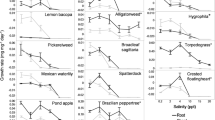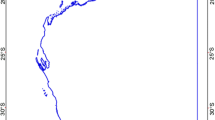Abstract
Alnus maritima (seaside alder) occurs in wet or flooded soils on the Delmarva Peninsula (southern Delaware and adjacent counties of eastern Maryland, USA) and in small niches in Georgia and Oklahoma. Although some A. maritima exist in coastal estuaries, responses of the species to salt, and whether salt resistance depends on provenance of plant origin, are not known. We first compared salt injury among A. maritima from all provenances irrigated with dilutions of ocean water. Seedlings from the three provenances responded similarly. Salinity up to 3.1 g/kg did not alter stem elongation but did cause increases in the ratio of dry to fresh weight of basipetal leaves, which reflected their necrosis. Photosynthesis and growth after treatment with salt then were compared among A. maritima and four other woody species: Baccharis halimifolia, Ceanothus americanus, Myrica cerifera, and Cornus amomum. Irrigation solutions with up to 12 g/kg salinity had no effect on B. halimifolia and caused no visible damage to M. Cerifera. Ceanothus americanus showed foliar necrosis and decreases in photosynthesis at 3, 6, and 12 g/kg. Photosynthesis of A. maritima and C. amomum was sustained after irrigating with solutions at 3 g/kg but was reduced by 6 and 12 g/kg salinity. Our third experiment showed a more pronounced decrease in photosynthesis as salinity increased for A. maritima with roots partially or totally inundated in solutions with salt compared to plants irrigated but not inundated with these solutions. Lastly, symptoms of salt injury among A. maritima planted at locations that differed in salinity along the Broadkill River, an estuary in Delaware, were found to be similar to those we documented among plants treated in a greenhouse. We conclude that necrosis of basipetal leaves is the most apparent symptom of injury caused by salt in the root zones of A. maritima, that low concentrations of salt can lead to damage, and that the rate at which symptoms develop in this riparian species varies with the extent of root-zone inundation with salt water. Alnus maritima was less sensitive than C. americanus to salt but was considerably more sensitive than B. halimifolia and M. cerifera.
Similar content being viewed by others
Literature cited
Bertness, M. D. 1999. The Ecology of Atlantic Shorelines. Sinauer Associates, Sunderland, MA, USA.
Cochran, W. G. and G. M. Cox. 1957. Experimental Designs, second edition. John Wiley & Sons, New York, NY, USA.
de Witt, III, W. 1968. The hydrography of the Broadkill River estuary. M.S. Thesis. University of Delaware, Lewes, DE, USA.
Dietert, M. F. and J. P. Shontz. 1978. Germination ecology of a Maryland population of saltmarsh bulrush (Scirpus robustus). Estuaries 1:164–170.
Dirr, M. A. 1998. Manual of Woody Landscape Plants: Their Identification, Ornamental Characteristics, Propagation and Uses. 5th edition. Stipes Publishing, Champaign, IL, USA.
Hellings, S. E. and J. L. Gallagher. 1992. The effects of salinity and flooding on Phragmites australis. Journal of Applied Ecology 29: 41–49.
Little, C. 2000. The Biology of Soft Shores and Estuaries. Oxford University Press, New York, NY, USA.
Sande, E. and D. R. Young. 1992. Effect of sodium chloride on growth and nitrogenase activity in seedlings of Myrica cerifera L. New Phytologist 120:345–350
Schrader, J. A. and W. R. Graves. 2000a. Seed germination and seedling growth of Alnus maritima from its three disjunct populations. Journal of the American Society for Horticultural Science 125:128–134.
Schrader, J. A. and W. R. Graves. 2000b. Timing of seed dispersal may limit the reproductive success of Alnus maritima. Castanea 65:69–77.
Schrader, J. A. and W. R. Graves. 2000c. Alnus maritima: a rare woody species from the New World. The New Plantsman 7:74–82.
Schrader, J. A. and W. R. Graves. 2002. Infraspecific systematics of Alnus maritima (Betulaceae) from three widely disjunct provenances. Castanea 67:380–401.
Stibolt, V. M. 1981. The distribution of Alnus maritima Muhl. ex Nutt. (Betulaceae). Castanea 46:195–200.
Tolliver, K. S., D. W. Martin, and D. R. Young. 1997. Freshwater and saltwater flooding response for woody species common to barrier island swales. Wetlands 17:10–18.
Wijte, A. H. B. M. and J. L. Gallagher. 1996. Effect of oxygen availability and salinity on early life history stages of salt marsh plants. II. Early seedling development advantage of Spartina alterniflora over Phragmites australis (Poaceae). American Journal of Botany 83:1343–1350.
Author information
Authors and Affiliations
Rights and permissions
About this article
Cite this article
Graves, W.R., Gallagher, J.L. Resistance to salinity of Alnus maritima from disjunct wetlands: Symptoms of salt injury, comparison to other shrubs, and effect of inundation. Wetlands 23, 394–405 (2003). https://doi.org/10.1672/14-20
Received:
Revised:
Accepted:
Issue Date:
DOI: https://doi.org/10.1672/14-20




